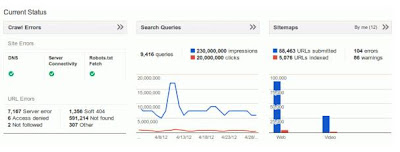Google announced on the Webmaster Central blog that they need cleaned up Google Webmaster Tools.
The three changes include:
A. Updated Dashboard
B. New Left Hand Navigation
C. Home Compact View
Here is an image of the revised dashboard:
The new navigation was modified to be a lot of representative of the content and tools at within the portal. Google explained:
Configuration: Stuff you configure and customarily don’t modification fairly often.
Health: Where you look to form positive things are OK.
Traffic: Where you attend perceive how your website is doing in Google search, who’s linking to you, where you'll be able to explore the information about your website.
Optimization: Where you'll be able to notice concepts to boost your website that permits us to higher perceive and represent your website in Search and alternative services.
The three changes include:
A. Updated Dashboard
B. New Left Hand Navigation
C. Home Compact View
Here is an image of the revised dashboard:
 |
The new navigation was modified to be a lot of representative of the content and tools at within the portal. Google explained:
Configuration: Stuff you configure and customarily don’t modification fairly often.
Health: Where you look to form positive things are OK.
Traffic: Where you attend perceive how your website is doing in Google search, who’s linking to you, where you'll be able to explore the information about your website.
Optimization: Where you'll be able to notice concepts to boost your website that permits us to higher perceive and represent your website in Search and alternative services.
